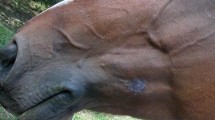Summary
„Pompholyx” as the oldest term for this disease in medical terminology, connoting a recurrent vesicular eruption on palms and soles, is recommended for general use in replacing a number of prejudicial terms connecting this condition either with a hypothetical and long reputed dysfunction of the sweat glands: dyshidrosis or with the causative role of fungi: epidermophytosis.
Publications of statistical investigations pertaining to the subject are reviewed. They show the amazing low percentage of pathogenic fungi which could be recovered in this condition.
Among clinically active cases, the lesions were microscopically negative in the ratio of 10% to 37%.
Clinically active and microscopically fungus-positive cases yielded from 80% to 95 % negative cultural results.
The present study of 983 cases showed 1.9% clinically active lesions on the feet. Microscopically and culturally all these cases were negative for any kind of pathogenic fungi.
During the camping period in mid-summer 1940, from June to late August, no prophylactic measures were taken to kill the fungi or to prevent their dissemination in locker rooms, on runways or shower rooms.
Despite this attitude there was no spread of fungi, no dissemination of infecting agents and no outburst of an epidemic of „epidermophytosis”.
Similar content being viewed by others
Bibliography
Andrews G. C. and Birkman F. W., New York State J. Med., 31, 1029–1031, (1931).
Becker S. W. and Ritchie E. B., Arch. Dermat. a. Syphil., 22, 790, (1930).
Benedek T., Dermat. Wochschr., 89, 1355–1357, (1929).
Benedek T., Dermat. Ztschr., 60, 58–66, (1930).
Benedek T., Dermat. Wchschr., 90, 633–641, (1930).
Benedek T., Dermat. Wchschr., 90, 166–177, (1930).
Benedek T., J. Trop. Med., 42, 81–86, (1939).
Benedek T., Mycopathologia, 1, 26–40, (1938).
Benedek T., Ztschr. f. Geburtsh. u. Gynäk., 104, 119–140, (1932).
Benedek T., Acta dermat.-venereol., 12, 38–80, (1931).
Benedek T., Acta dermat.-venereol., 13, 150–200, (1932).
Benedek T., IX Congr. Internat. Dermatolog., Budapest, 1935, 2, 986–987, (1935).
Bruhns und Alexander, Allgemeine Mykologie in Jadassohn's Handbuch d. Haut- u. Geschlechtskr., XI, I, Springer, Berlin, (1928).
Butler C. S., Houghton J. E. and Cooper G. F., U. S. Nav. Med. Bull., 21, 615–630, (1924).
Cremer G., Arch. f. Dermat. u. Syphil., 169, 244–258, (1933).
Fox T., Amer. J. Dermat., 4, 1–8, (1873).
Fraser P. K., J. Trop. Med., 42, 141–145, (1939).
Gilman R. L., Pennsylvania Med. J., April (1933).
Graffenried v., Dermat. Wchschr., 66, 21, (1918).
Griff, Fanny and Itkin, Acta Dermat.-venereol., 11, 508, (1930).
Hopkins J. G., Pennsylvania Med. J., March, (1938).
Hulsey S. H. and Jordan F. M., Am. J. Med. Sci., 169, 267, (1925).
Kadisch E., Dermat. Wchschr., 89, 1423–1433, (1929).
Kaufmann-Wolff M., Dermat. Ztschr., 21, (1914).
Legge R. T., Bonar Lee and Templeton H. J., J. Amer. Med. Ass., 92, 1507, (1929).
Legge R. T., Bonar Lee and Templeton, J. Amer. Med. Ass., 93, 17, (1929).
MacKee G. M. and Lewis G. M., Arch. Dermat. a. Syphil., 23, 445, (1931).
Robinson A. R., Arch. Dermat., 3, 289–303, July 1877, New York.
Strickler A. and Friedman R., Arch. Dermat. a. Syphil., 24, 430–445, (1931).
Weidman F. D., Arch. Dermat. a. Syphil., 15, 415–450, (1927).
White C. J., Arch. Dermat. a. Syphil., 20, 315–319, (1929).
Williams C. M., Arch. Dermat. a. Syphil., 15, 541, (1927).
Williams J. W., Urol. a. Cutan. Rev., 41, (2), (1937).
Author information
Authors and Affiliations
Rights and permissions
About this article
Cite this article
Benedek, T. Pompholyx (Epidermophytosis, Dermatophytosis, Ringworm of the feet, infectious eczematoid dermatitis or ringworm, dyshidrosis). Mycopathologia 3, 240–254 (1943). https://doi.org/10.1007/BF00446029
Published:
Issue Date:
DOI: https://doi.org/10.1007/BF00446029




